I'm at the one year mark with my first Marine aquarium (20 gallon AIO). The sand substrate is 25% Caribsea Bahamas Oolite, 75% Caribsea Fiji Pink sand. After about 10 months the sand looks perpetually "dirty", no longer white new tank look. I vacuum the top layer and/or do a full sand bed vacuum every 3-4 weeks during water changes. The sand bed just seems to look darker and dirtier over time despite good cleaning. I use the small diameter Python Pro Clean gravel vacuum. Inhabitants are 1 lawnmower blenny, 1 clown fish, 1 saltwater molly, 1 cleaner shrimp, 1 fighter conch snail, 3 bumble bee snails, 5 or 6 blue leg hermit crabs, 1 other small snail. Good amount of coral in the tank. I am upgrading to 50 gallon in a week and am hoping there is sand that still looks good at a year? Or is that a pipe dream. I don't plan on having sand sifting starfish or goibies for small diameter grain sand. I live in apartment and rinsing dry sand will be difficult task. Any experience with sand looking dirty over the moths? Any experiences with sand that still looks good over the months? Thank you!
Navigation
Install the app
How to install the app on iOS
Follow along with the video below to see how to install our site as a web app on your home screen.
Note: This feature may not be available in some browsers.
More options
You are using an out of date browser. It may not display this or other websites correctly.
You should upgrade or use an alternative browser.
You should upgrade or use an alternative browser.
Does Sand Become "Dirty" over time? Best Sand Suggestions Please!
- Thread starter KenBabich
- Start date
- Tagged users None
i cant think
Wrasse Addict
View Badges
Excellence Award
Reef Tank 365
Article Contributor
UK Reef Club Member
Rock Pool Reef Keepers
My Tank Thread
My Aquarium Showcase
Do you mean dirty as in on the top or dirty as in against the sides?I'm at the one year mark with my first Marine aquarium (20 gallon AIO). The sand substrate is 25% Caribsea Bahamas Oolite, 75% Caribsea Fiji Pink sand. After about 10 months the sand looks perpetually "dirty", no longer white new tank look. I vacuum the top layer and/or do a full sand bed vacuum every 3-4 weeks during water changes. The sand bed just seems to look darker and dirtier over time despite good cleaning. I use the small diameter Python Pro Clean gravel vacuum. Inhabitants are 1 lawnmower blenny, 1 clown fish, 1 saltwater molly, 1 cleaner shrimp, 1 fighter conch snail, 3 bumble bee snails, 5 or 6 blue leg hermit crabs, 1 other small snail. Good amount of coral in the tank. I am upgrading to 50 gallon in a week and am hoping there is sand that still looks good at a year? Or is that a pipe dream. I don't plan on having sand sifting starfish or goibies for small diameter grain sand. I live in apartment and rinsing dry sand will be difficult task. Any experience with sand looking dirty over the moths? Any experiences with sand that still looks good over the months? Thank you!
Mine is clean at 2 years. It will never look completely sterile white and that looks unnatural imo. What you seem to be missing is nassarius snails. They do a great job turning over the sand. I would add at least 10 good sized nassarius to your 50 gallon.
On the top. It just seems to not be as white as before. Thank you for the response. I can't take good clear photos of the sand with my iPhone. Maybe I need to use a vacuum with larger tubing to really suck up the material. I have no nitrite/nitrate problems. Maybe it's me and the upgrade itch - tired of the sand!Do you mean dirty as in on the top or dirty as in against the sides?
Thank you for the suggestionMine is clean at 2 years. It will never look completely sterile white and that looks unnatural imo. What you seem to be missing is nassarius snails. They do a great job turning over the sand. I would add at least 10 good sized nassarius to your 50 gallon.
i cant think
Wrasse Addict
View Badges
Excellence Award
Reef Tank 365
Article Contributor
UK Reef Club Member
Rock Pool Reef Keepers
My Tank Thread
My Aquarium Showcase
Generally, the best way to get a whiter sandbed is through snails and in larger tanks (3-4’x2’) there are wrasses we can use to turn sand over.On the top. It just seems to not be as white as before. Thank you for the response. I can't take good clear photos of the sand with my iPhone. Maybe I need to use a vacuum with larger tubing to really suck up the material. I have no nitrite/nitrate problems. Maybe it's me and the upgrade itch - tired of the sand!
Generally, the best way to get a whiter sandbed is through snails and in larger tanks (3-4’x2’) there are wrasses we can use to turn sand over.
See this Ken? I cant think is being subtle. Start looking at glossy photos of wrasses and plan your new 120. You will certainly have nice clean sand
1 - Whoa! 120? So soon? LOL. My 50 gallon is sitting in place ready to go! Am I to bypass and jump to 120? LOLSee this Ken? I cant think is being subtle. Start looking at glossy photos of wrasses and plan your new 120. You will certainly have nice clean sand
2- "I can't think" being is being subtle? LOL. Did look at photos of green and red wrasses - they sure due look pretty!
3 - where in CA are you located if I may ask.
When cleaning the sb it’s best to do a section at a time with your water changes. Not to disturb the bacteria and upset the balance of the system. Also plus to the nassarius
So... I'm going to go against the grain and say stir it a little every time you clean your glass. I run UV so trying to "save" bacteria is counter productive like so many other things in this hobby. I have large fish and even with a huge clean up crew the sand bed needs a good stir to get all the "crap" suspended and filtered. Flow doesn't get it all.
when I use the long feeding pipe to clean detritus off some low flow areas I also hit the sand bed and stir up some nutrients. Corals seem to like the dirt. Lol. Not a dsb type situation. My Melanarus follows me and hits the lil nuggets the get l suspended in wc
I always stir top .5” of sandbed, everybody eats better including corals, anemone, flame scallops & sea apple.So... I'm going to go against the grain and say stir it a little every time you clean your glass. I run UV so trying to "save" bacteria is counter productive like so many other things in this hobby. I have large fish and even with a huge clean up crew the sand bed needs a good stir to get all the "crap" suspended and filtered. Flow doesn't get it all.
I did the same until I decided to put 11 sand sleeping wrasses in the tank lol. Now lights ramp down/out gets the sand stirred up every time lol.I always stir top .5” of sandbed, everybody eats better including corals, anemone, flame scallops & sea apple.
When I ran dsb with Jaubert plenum for 20 years, I got a Melarius Wrasse that in addittion to being gorgeous was “detrivore deadly”. I initially got wrasse to deal with red Planaria, not anticipating him eating every type of detrivore. Flame Scallops & Sea Apples meant more to me than the Wrasse and I gifted it to a friend.I did the same until I decided to put 11 sand sleeping wrasses in the tank lol. Now lights ramp down/out gets the sand stirred up every time lol.
My tank has been up for 3 years come March, I have never touched the sand until last month, I did a section at a time, about 10g or 2 buckets of water, was nasty as could be. Sand looks great now and I have decided I won't wait so long next time, perhaps every 3 months.
The nasty sand you removed is the breeding ground for the microbial loop to process both inorganic & organic nutrients into live food for hungry mouths in display. This is what @Paul B says about detritus & MULM:My tank has been up for 3 years come March, I have never touched the sand until last month, I did a section at a time, about 10g or 2 buckets of water, was nasty as could be. Sand looks great now and I have decided I won't wait so long next time, perhaps every 3 months.
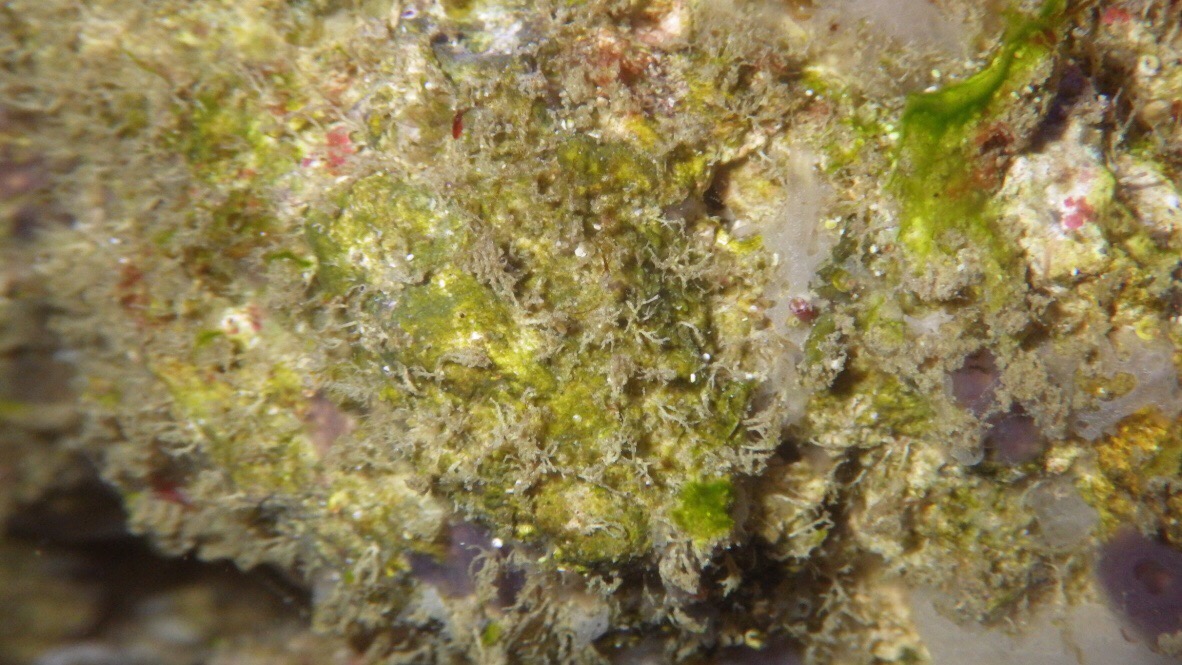
"Mulm" in a reef tank
I think one of the most important, and least understood or mentioned things in a reef tank is "mulm". That stuff that grows in the dark portions of a tank if it is set up long enough. "Mulm" is a combination of algae, sponges, bacteria, pods, worms, detritus, poop and any thing else that can be p...
 wamas.org
wamas.org
This is what science says about the “microbial loop”
The microbial loop describes a trophic pathway where, in aquatic systems, dissolved organic carbon (DOC) is returned to higher trophic levels via its incorporation into bacterial biomass, and then coupled with the classic food chain formed by phytoplankton-zooplankton-nekton. In soil systems, the microbial loop refers to soil carbon. The term microbial loop was coined by Farooq Azam, Tom Fenchel et al.[1]in 1983 to include the role played by bacteria in the carbon and nutrient cycles of the marine environment.
In general, dissolved organic carbon (DOC) is introduced into the ocean environment from bacterial lysis, the leakage or exudation of fixed carbon from phytoplankton (e.g., mucilaginous exopolymer from diatoms), sudden cell senescence, sloppy feeding by zooplankton, the excretion of waste products by aquatic animals, or the breakdown or dissolution of organic particles from terrestrial plants and soils.[2]Bacteria in the microbial loop decompose this particulate detritus to utilize this energy-rich matter for growth. Since more than 95% of organic matter in marine ecosystems consists of polymeric, high molecular weight (HMW) compounds (e.g., protein, polysaccharides, lipids), only a small portion of total dissolved organic matter (DOM) is readily utilizable to most marine organisms at higher trophic levels. This means that dissolved organic carbon is not available directly to most marine organisms; marine bacteria introduce this organic carbon into the food web, resulting in additional energy becoming available to higher trophic levels. Recently the term "microbial food web" has been substituted for the term "microbial loop".
It is amazing that with all of the wrasse, I still have a ton of life in the sand. They do not sleep everywhere and turn it over everywhere, so all the critters just congregate near the rocks, in areas that the wrasse do not sleep in and in the sand in the sump. I do not think I could run a tank with a "pristine" sanded. Too many NPS corals that rely on things getting kicked up for them to eat.The nasty sand you removed is the breeding ground for the microbial loop to process both inorganic & organic nutrients into live food for hungry mouths in display. This is what @Paul B says about detritus & MULM:

"Mulm" in a reef tank
I think one of the most important, and least understood or mentioned things in a reef tank is "mulm". That stuff that grows in the dark portions of a tank if it is set up long enough. "Mulm" is a combination of algae, sponges, bacteria, pods, worms, detritus, poop and any thing else that can be p...wamas.org
This is what science says about the “microbial loop”
The microbial loop describes a trophic pathway where, in aquatic systems, dissolved organic carbon (DOC) is returned to higher trophic levels via its incorporation into bacterial biomass, and then coupled with the classic food chain formed by phytoplankton-zooplankton-nekton. In soil systems, the microbial loop refers to soil carbon. The term microbial loop was coined by Farooq Azam, Tom Fenchel et al.[1]in 1983 to include the role played by bacteria in the carbon and nutrient cycles of the marine environment.
In general, dissolved organic carbon (DOC) is introduced into the ocean environment from bacterial lysis, the leakage or exudation of fixed carbon from phytoplankton (e.g., mucilaginous exopolymer from diatoms), sudden cell senescence, sloppy feeding by zooplankton, the excretion of waste products by aquatic animals, or the breakdown or dissolution of organic particles from terrestrial plants and soils.[2]Bacteria in the microbial loop decompose this particulate detritus to utilize this energy-rich matter for growth. Since more than 95% of organic matter in marine ecosystems consists of polymeric, high molecular weight (HMW) compounds (e.g., protein, polysaccharides, lipids), only a small portion of total dissolved organic matter (DOM) is readily utilizable to most marine organisms at higher trophic levels. This means that dissolved organic carbon is not available directly to most marine organisms; marine bacteria introduce this organic carbon into the food web, resulting in additional energy becoming available to higher trophic levels. Recently the term "microbial food web" has been substituted for the term "microbial loop".
I'm at the one year mark with my first Marine aquarium (20 gallon AIO). The sand substrate is 25% Caribsea Bahamas Oolite, 75% Caribsea Fiji Pink sand. After about 10 months the sand looks perpetually "dirty", no longer white new tank look. I vacuum the top layer and/or do a full sand bed vacuum every 3-4 weeks during water changes. The sand bed just seems to look darker and dirtier over time despite good cleaning. I use the small diameter Python Pro Clean gravel vacuum. Inhabitants are 1 lawnmower blenny, 1 clown fish, 1 saltwater molly, 1 cleaner shrimp, 1 fighter conch snail, 3 bumble bee snails, 5 or 6 blue leg hermit crabs, 1 other small snail. Good amount of coral in the tank. I am upgrading to 50 gallon in a week and am hoping there is sand that still looks good at a year? Or is that a pipe dream. I don't plan on having sand sifting starfish or goibies for small diameter grain sand. I live in apartment and rinsing dry sand will be difficult task. Any experience with sand looking dirty over the moths? Any experiences with sand that still looks good over the months? Thank you!
Considering just the 'dirty' look of a sand bed, if the sand or gravel is not stirred then the top layer develops a coating of various tiny organisms which includes small brown/green alga (you can see them as flecks and/or short strings with a good hand magnifying glass). When the gravel is stirred frequently, the alga are greatly reduced due to being buried much of the time without light and the sand will look cleaner.
Ken,I'm at the one year mark with my first Marine aquarium (20 gallon AIO). The sand substrate is 25% Caribsea Bahamas Oolite, 75% Caribsea Fiji Pink sand. After about 10 months the sand looks perpetually "dirty", no longer white new tank look. I vacuum the top layer and/or do a full sand bed vacuum every 3-4 weeks during water changes. The sand bed just seems to look darker and dirtier over time despite good cleaning. I use the small diameter Python Pro Clean gravel vacuum. Inhabitants are 1 lawnmower blenny, 1 clown fish, 1 saltwater molly, 1 cleaner shrimp, 1 fighter conch snail, 3 bumble bee snails, 5 or 6 blue leg hermit crabs, 1 other small snail. Good amount of coral in the tank. I am upgrading to 50 gallon in a week and am hoping there is sand that still looks good at a year? Or is that a pipe dream. I don't plan on having sand sifting starfish or goibies for small diameter grain sand. I live in apartment and rinsing dry sand will be difficult task. Any experience with sand looking dirty over the moths? Any experiences with sand that still looks good over the months? Thank you!
This sand is 25 years old in my tank and the aroggonite that makes up this substrate is recycled minerals from animas & things.
I have not cleaned glass or sand in over a week.
@KenBabich
Your definition of ”dirty sand” and mine may differ. Please post a full tank shot of dirty sand under white lights from your reef lighting. Phone camera will work just fine for helping us to see your system. I looked for a tank thread to get more details of your 20G AIO
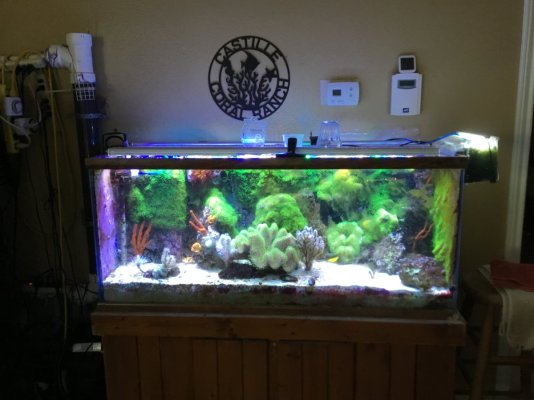
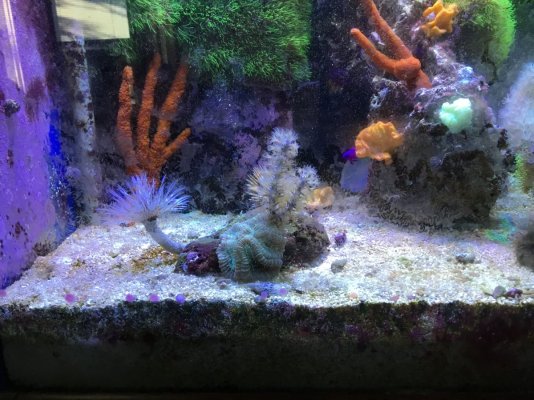
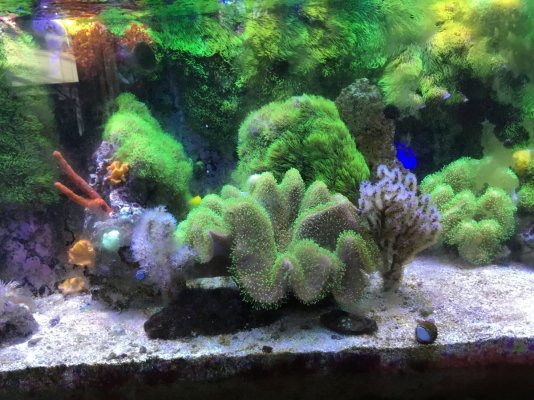
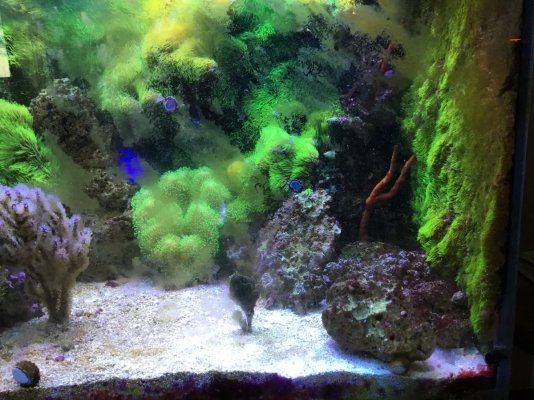
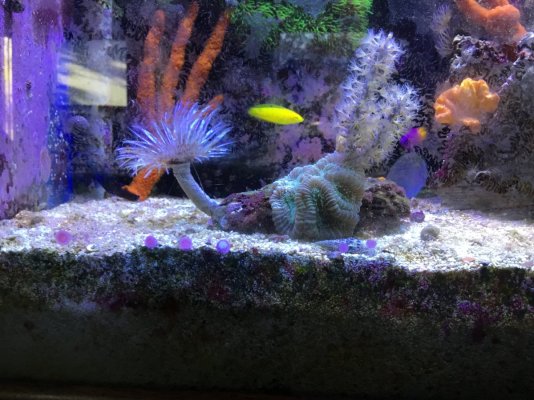
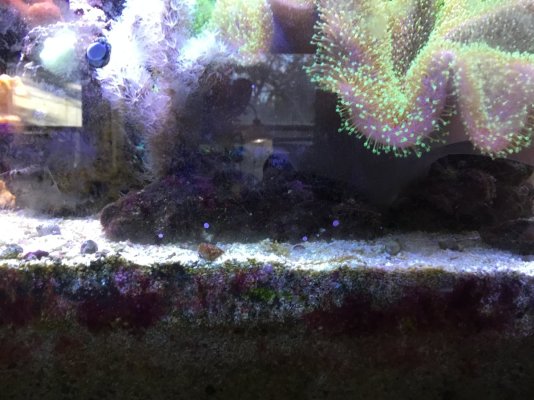
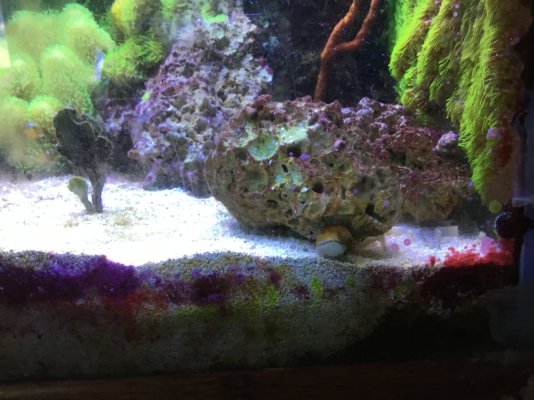
Last edited:
Not sure if this is good or bad but I Python vacuum a good percentage (maybe 50% ?) of my sand bed as my water change method.
*also, nassarius snails and tiger conch probably clean it up a bit on a continuous basis
*also, nassarius snails and tiger conch probably clean it up a bit on a continuous basis
Similar threads
- Replies
- 3
- Views
- 236
- Replies
- 6
- Views
- 314
- Replies
- 2
- Views
- 101
- Replies
- 6
- Views
- 506
















